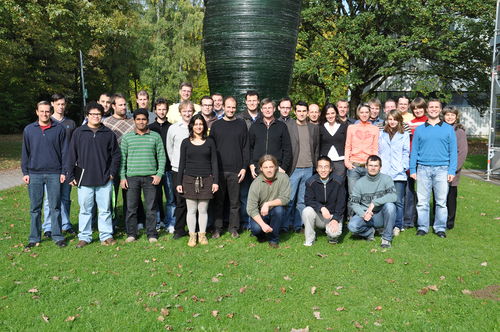Difference between revisions of "Main Page"
(→News) |
|||
| Line 9: | Line 9: | ||
== News == | == News == | ||
| + | |||
| + | * The ICP has moved on Stuttgart's university campus to '''Allmandring 3''' ([[How to find us|Map]]). Please change your address book accordingly! | ||
* From '''October 8-12, 2012''', the ICP conducts the '''[http://www.cecam.org CECAM] - [http://www.simtech.uni-stuttgart.de SimTech] - [http://espressomd.org/wordpress/ess2012 ESPResSo Summer School]''' "”Simulating Soft Matter with ESPResSo, ESPResSo++ and VOTCA”", a one-week school about the MD program {{es}} and related tools. The course is an official course for students of Stuttgart University. For further details or registration, please visit the [http://espressomd.org/wordpress/ess2012 homepage of the ESPResSo Summer School 2012]. | * From '''October 8-12, 2012''', the ICP conducts the '''[http://www.cecam.org CECAM] - [http://www.simtech.uni-stuttgart.de SimTech] - [http://espressomd.org/wordpress/ess2012 ESPResSo Summer School]''' "”Simulating Soft Matter with ESPResSo, ESPResSo++ and VOTCA”", a one-week school about the MD program {{es}} and related tools. The course is an official course for students of Stuttgart University. For further details or registration, please visit the [http://espressomd.org/wordpress/ess2012 homepage of the ESPResSo Summer School 2012]. | ||
| Line 17: | Line 19: | ||
* Our institute's [http://www.icp.uni-stuttgart.de/microct '''world record 3d images'''] of a porous microstructure were highlighted in the December issue of [http://www.pro-physik.de/phy/zeitschriften/oupissue.html Optik & Photonik, vol 6, p. 15 (2011)] and earlier on [http://www.pro-physik.de/details/news/1380843/Weltrekord_in_3D-Bildgebung_eines_Sandsteins.html pro-physik.de]. For [http://www.icp.uni-stuttgart.de/microct more information], [http://link.aps.org/doi/10.1103/PhysRevE.84.062301 publication] and [http://www.icp.uni-stuttgart.de/microct download of our 3d images click here]. | * Our institute's [http://www.icp.uni-stuttgart.de/microct '''world record 3d images'''] of a porous microstructure were highlighted in the December issue of [http://www.pro-physik.de/phy/zeitschriften/oupissue.html Optik & Photonik, vol 6, p. 15 (2011)] and earlier on [http://www.pro-physik.de/details/news/1380843/Weltrekord_in_3D-Bildgebung_eines_Sandsteins.html pro-physik.de]. For [http://www.icp.uni-stuttgart.de/microct more information], [http://link.aps.org/doi/10.1103/PhysRevE.84.062301 publication] and [http://www.icp.uni-stuttgart.de/microct download of our 3d images click here]. | ||
| − | |||
| − | |||
| − | |||
| − | |||
| − | |||
| − | |||
| − | |||
| − | |||
| − | |||
| − | |||
| − | |||
| − | |||
== Contact == | == Contact == | ||
Revision as of 12:24, 26 September 2012

We use high-performance computing on supercomputers and parallel clusters to solve complex problems in physics that would otherwise be impossible to solve via analytical methods. Our main research areas are presently to understand the physics of soft matter systems in general, with a particular emphasis on charged systems like polyelectrolytes, charged colloids, ferrofluids and ionic liquids. In addition we are interested in various biophysical problems. A second focus of our research are geometry, flow and transport phenomena in porous media and applications of fractional calculus in physics. Our methods are not only computer simulations, but we also apply numerical methods statistical physics approaches like stochastic processes, density functional methods, and other approaches. The simulations are performed on parallel computers with help of the simulation package ESPResSo, and we continue to develop algorithms for long range interactions.
News
- The ICP has moved on Stuttgart's university campus to Allmandring 3 (Map). Please change your address book accordingly!
- From October 8-12, 2012, the ICP conducts the CECAM - SimTech - ESPResSo Summer School "”Simulating Soft Matter with ESPResSo, ESPResSo++ and VOTCA”", a one-week school about the MD program ESPResSo and related tools. The course is an official course for students of Stuttgart University. For further details or registration, please visit the homepage of the ESPResSo Summer School 2012.
- On June 15, the Stuttgart cluster of excellence SimTech has succeeded in the competition for the second phase of the German Excellence initiative. Congratulations from ICP!
- Maria Fyta has joined the SFB716 as junior professor. She will work at ICP on multiscale atomistic and mesoscopic simulations of biologically functionalized surfaces and nanoparticles, DNA translocation through nanopores and elastic and opto-electronic properties of carbon-based materials.
- Our institute's world record 3d images of a porous microstructure were highlighted in the December issue of Optik & Photonik, vol 6, p. 15 (2011) and earlier on pro-physik.de. For more information, publication and download of our 3d images click here.
Contact
Please note that the ICP has moved on the campus of Stuttgart University!
Prof. Dr. Christian Holm (Director)
Rudolf Hilfer Fax: 49-(0)711/685-6-3658 |
Institute for Computational Physics
Universität Stuttgart Allmandring 3 70569 Stuttgart Germany How to find us? |
Professor Holm's Office Hours: Monday, 13:15 - 14:00
Professor Hilfer Sprechstunde: Donnerstag 13:00 - 13:30 JP Arnold's Office Hours: Monday-Friday, 10:00 - 17:00 JP Fyta's Office Hours: Monday-Friday, 10:00 - 12:00 |

